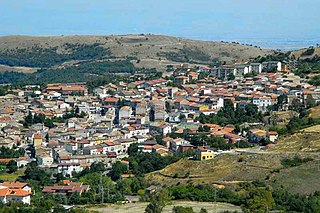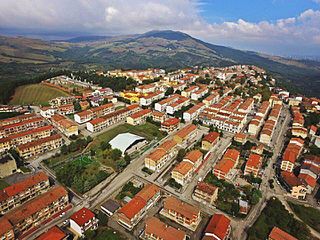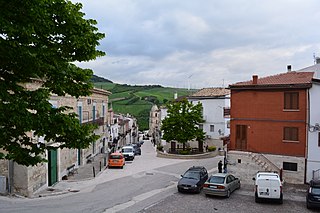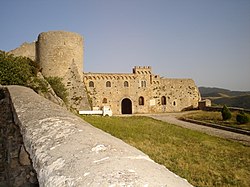
Apulia, also known by its Italian name Puglia, is a region of Italy, located in the southern peninsular section of the country, bordering the Adriatic Sea to the east, the Strait of Otranto and Ionian Sea to the southeast and the Gulf of Taranto to the south. The region comprises 19,345 square kilometers (7,469 sq mi), and its population is about four million people. It is bordered by the other Italian regions of Molise to the north, Campania to the west, and Basilicata to the southwest. The regional capital is Bari.

Molise is a region of Southern Italy. Until 1963, it formed part of the region of Abruzzi e Molise together with Abruzzo. The split, which did not become effective until 1970, makes Molise the newest region in Italy. Covering 4,438 square kilometres (1,714 sq mi), it is the second smallest region in the country, after the Aosta Valley, and has a population of 313,348.

Greccio is an old hilltown and comune of the province of Rieti in the Italian region of Lazio, overhanging the Rieti Valley on a spur of the Monti Sabini, a sub-range of the Apennines, about 16 kilometres by road northwest of Rieti, the nearest large town.

Sassoferrato is a town and comune of the province of Ancona in the Marche region of central-eastern Italy. It is one of I Borghi più belli d'Italia.

The province of Foggia is a province in the Apulia region of Italy.

Massa Martana is an ancient Italian town and comune in the Monti Martani mountain range in the province of Perugia (Umbria). It is 10 km N of Acquasparta, 18 km N of San Gemini and 32 km N of Narni; 14 km S of Bastardo and 27 km S of Bevagna. As of the 2003 census, the town had 3558 inhabitants.

Foggia is a city and comune (municipality) of Apulia, in Southern Italy, capital of the province of Foggia. In 2013, its population was 153,143. Foggia is the main city of a plain called Tavoliere, also known as the "granary of Italy".

Savignano Irpino is a village and comune in the province of Avellino, in the Campania region of southern Italy.

Monte Sant'Angelo is a town and comune of Apulia, southern Italy, in the province of Foggia, on the southern slopes of Monte Gargano. It is one of I Borghi più belli d'Italia.

Cerignola is a town and comune of Apulia, Italy, in the province of Foggia, 40 kilometres southeast from the town of Foggia. It has the third-largest land area of any comune in Italy, at 593.71 square kilometres (229.23 sq mi), after Rome and Ravenna and it has the largest land area of any comune in Italy among those that are not the provincial capital. In 2017, it had a population of 58,534.

Cingoli is a town and comune of the Marches, Italy, in the province of Macerata, about 27 kilometres (17 mi) by road from the town of Macerata. It is the birthplace of Pope Pius VIII. It is one of I Borghi più belli d'Italia.

Orsara di Puglia is a small town and comune in the province of Foggia, Apulia, southern Italy.

Cisternino is a comune in the province of Brindisi in Apulia, on the coast of south-eastern Italy, approximately 50 kilometres (31 mi) north-west of the city of Brindisi. It is one of I Borghi più belli d'Italia. Its main economic activities are tourism, the growing of olives and grapes, and dairy farming.

Accadia is a town and comune in the province of Foggia in the Apulia region of southeast Italy. Until the mid-20th century it was just within the eastern frontier of the region of Campania in the province of Avellino.

Alberona is an upland village and comune of the province of Foggia and region of Apulia, in southeast Italy. It is one of I Borghi più belli d'Italia.

Pietramontecorvino is a town and comune in the province of Foggia in the Apulia region of southeast Italy. It is located in the Monti Dauni, on a rocky spur commanding the valley of the Triolo, a right tributary of the Candelaro river. It is one of I Borghi più belli d'Italia.

Panni is a village and comune in the province of Foggia in the Apulia region of southeast Italy.

Specchia is a town and comune in the province of Lecce in the Apulia region of southeast Italy. Located 53 km south of the province's capital, Specchia is nestled atop the Serra Magnone, one of the highest points in lower Salento. It is one of I Borghi più belli d'Italia.

Coreglia Antelminelli is a comune (municipality) in the Province of Lucca in the Italian region Tuscany, located about 70 kilometres (43 mi) northwest of Florence and about 25 kilometres (16 mi) north of Lucca.

The Tavoliere delle Puglie is a plain in northern Apulia, southern Italy, occupying nearly a half of the Capitanata traditional region. It covers a surface of c. 3,000 km2, once constituting a sea bottom: it is bounded by the Daunian Pre-Apennines on the West, the Gargano Promontory and the Adriatic Sea on the East, by the Fortore river on the north, and the Ofanto river on the south. It is the largest Italian plain after the Pianura Padana.























